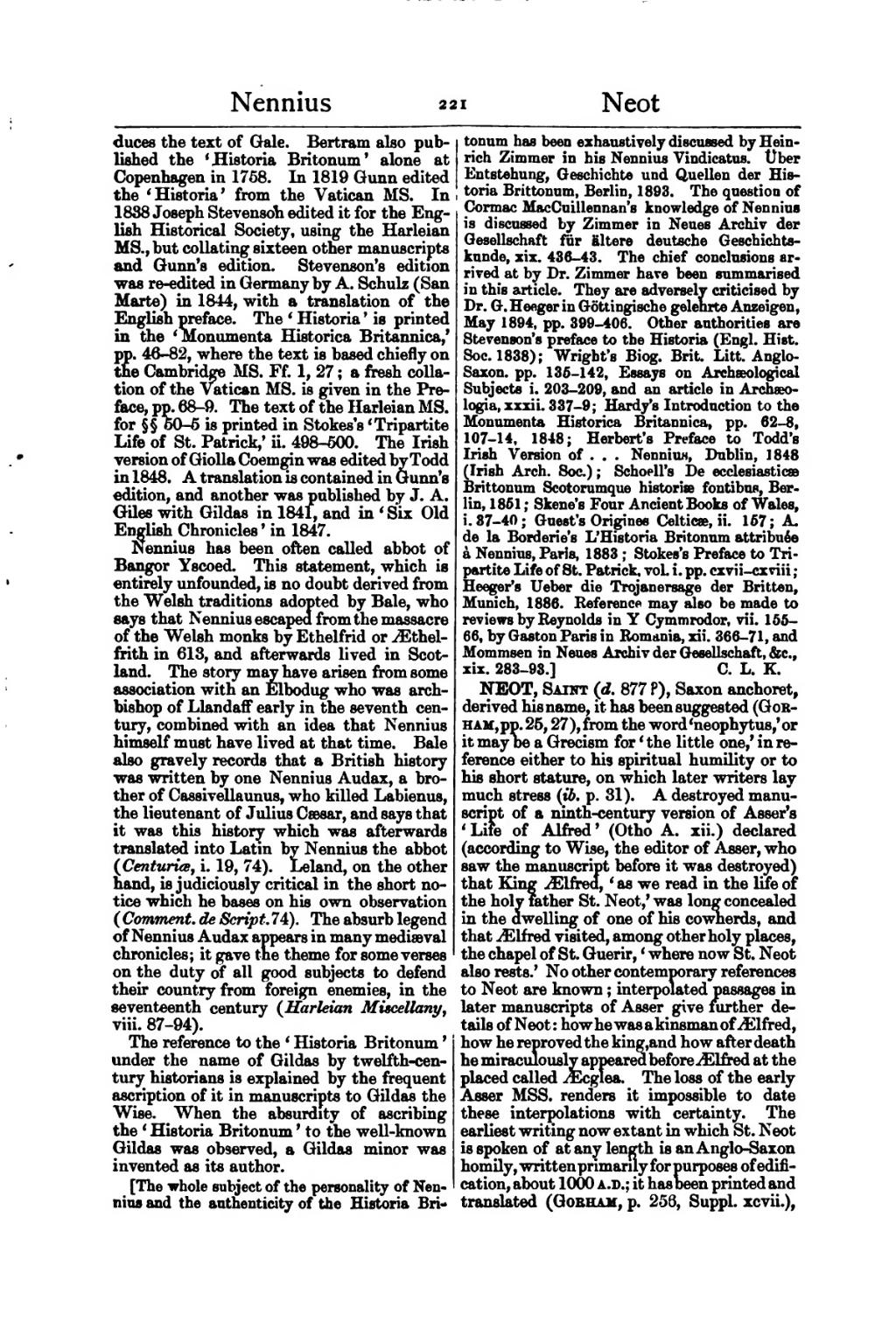duces the text of Gale. Bertram also published the ‘Historia Britonum’ alone at Copenhagen in 1758. In 1819 Gunn edited the ‘Historia’ from the Vatican MS. In 1838 Joseph Stevenson edited it for the English Historical Society, using the Harleian MS., but collating sixteen other manuscripts and Gunn's edition. Stevenson's edition was re-edited in Germany by A. Schulz (San Marte) in 1844, with a translation of the English preface. The ‘Historia’ is printed in the ‘Monumenta Historica Britannica,’ pp. 46–82, where the text is based chiefly on the Cambridge MS. Ff. 1, 27; a fresh collation of the Vatican MS. is given in the Preface, pp. 68–9. The text of the Harleian MS. for §§ 50–5 is printed in Stokes's ‘Tripartite Life of St. Patrick,’ ii. 498–500. The Irish version of Giolla Coemgin was edited by Todd in 1848. A translation is contained in Gunn's edition, and another was published by J. A. Giles with Gildas in 1841, and in ‘Six Old English Chronicles’ in 1847.
Nennius has been often called abbot of Bangor Yscoed. This statement, which is entirely unfounded, is no doubt derived from the Welsh traditions adopted by Bale, who says that Nennius escaped from the massacre of the Welsh monks by Ethelfrid or Æthelfrith in 613, and afterwards lived in Scotland. The story may have arisen from some association with an Elbodug who was archbishop of Llandaff early in the seventh century, combined with an idea that Nennius himself must have lived at that time. Bale also gravely records that a British history was written by one Nennius Audax, a brother of Cassivellaunus, who killed Labienus, the lieutenant of Julius Cæsar, and says that it was this history which was afterwards translated into Latin by Nennius the abbot (Centuriæ, i. 19, 74). Leland, on the other hand, is judiciously critical in the short notice which he bases on his own observation (Comment. de Script. 74). The absurb legend of Nennius Audax appears in many mediæval chronicles; it gave the theme for some verses on the duty of all good subjects to defend their country from foreign enemies, in the seventeenth century (Harleian Miscellany, viii. 87–94).
The reference to the ‘Historia Britonum’ under the name of Gildas by twelfth-century historians is explained by the frequent ascription of it in manuscripts to Gildas the Wise. When the absurdity of ascribing the ‘Historia Britonum’ to the well-known Gildas was observed, a Gildas minor was invented as its author.
[The whole subject of the personality of Nennius and the authenticity of the Historia Britonum has been exhaustively discussed by Heinrich Zimmer in his Nennius Vindicatus. Über Entstehung, Geschichte und Quellen der Historia Brittonum, Berlin, 1893. The question of Cormac MacCuillennan's knowledge of Nennius is discussed by Zimmer in Neues Archiv der Gesellschaft für ältere deutsche Geschichtskunde, xix. 436–43. The chief conclusions arrived at by Dr. Zimmer have been summarised in this article. They are adversely criticised by Dr. G. Heeger in Göttingische gelehrte Anzeigen, May 1894, pp. 399–406. Other authorities are Stevenson's preface to the Historia (Engl. Hist. Soc. 1838); Wright's Biog. Brit. Litt. Anglo-Saxon. pp. 135–142, Essays on Archæological Subjects i. 203–209, and an article in Archæologia, xxxii. 337–9; Hardy's Introduction to the Monumenta Historica Britannica, pp. 62–8, 107–14, 1848; Herbert's Preface to Todd's Irish Version of … Nennius, Dublin, 1848 (Irish Arch. Soc.); Schoell's De ecclesiasticæ Brittonum Scotorumque historiæ fontibus, Berlin, 1851; Skene's Four Ancient Books of Wales, i. 37–40; Guest's Origines Celticæ, ii. 157; A. de la Borderie's L'Historia Britonum attribuée à Nennius, Paris, 1883; Stokes's Preface to Tripartite Life of St. Patrick, vol. i. pp. cxvii–cxviii; Heeger's Ueber die Trojanersage der Britten, Munich, 1886. Reference may also be made to reviews by Reynolds in Y Cymmrodor, vii. 155–66, by Gaston Paris in Romania, xii. 366–71, and Mommsen in Neues Archiv der Gesellschaft, &c., xix. 283–93.]
NEOT, Saint (d. 877?), Saxon anchoret, derived his name, it has been suggested (Gorham, pp. 25, 27), from the word ‘neophytus,’ or it may be a Grecism for ‘the little one,’ in reference either to his spiritual humility or to his short stature, on which later writers lay much stress (ib. p. 31). A destroyed manuscript of a ninth-century version of Asser's ‘Life of Alfred’ (Otho A. xii.) declared (according to Wise, the editor of Asser, who saw the manuscript before it was destroyed) that King Ælfred, ‘as we read in the life of the holy father St. Neot,’ was long concealed in the dwelling of one of his cowherds, and that Ælfred visited, among other holy places, the chapel of St. Guerir, ‘where now St. Neot also rests.’ No other contemporary references to Neot are known; interpolated passages in later manuscripts of Asser give further details of Neot: how he was a kinsman of Ælfred, how he reproved the king, and how after death he miraculously appeared before Ælfred at the placed called Æcglea. The loss of the early Asser MSS. renders it impossible to date these interpolations with certainty. The earliest writing now extant in which St. Neot is spoken of at any length is an Anglo-Saxon homily, written primarily for purposes of edification, about 1000 A.D.; it has been printed and translated (Gorham, p. 256, Suppl. xcvii.),
